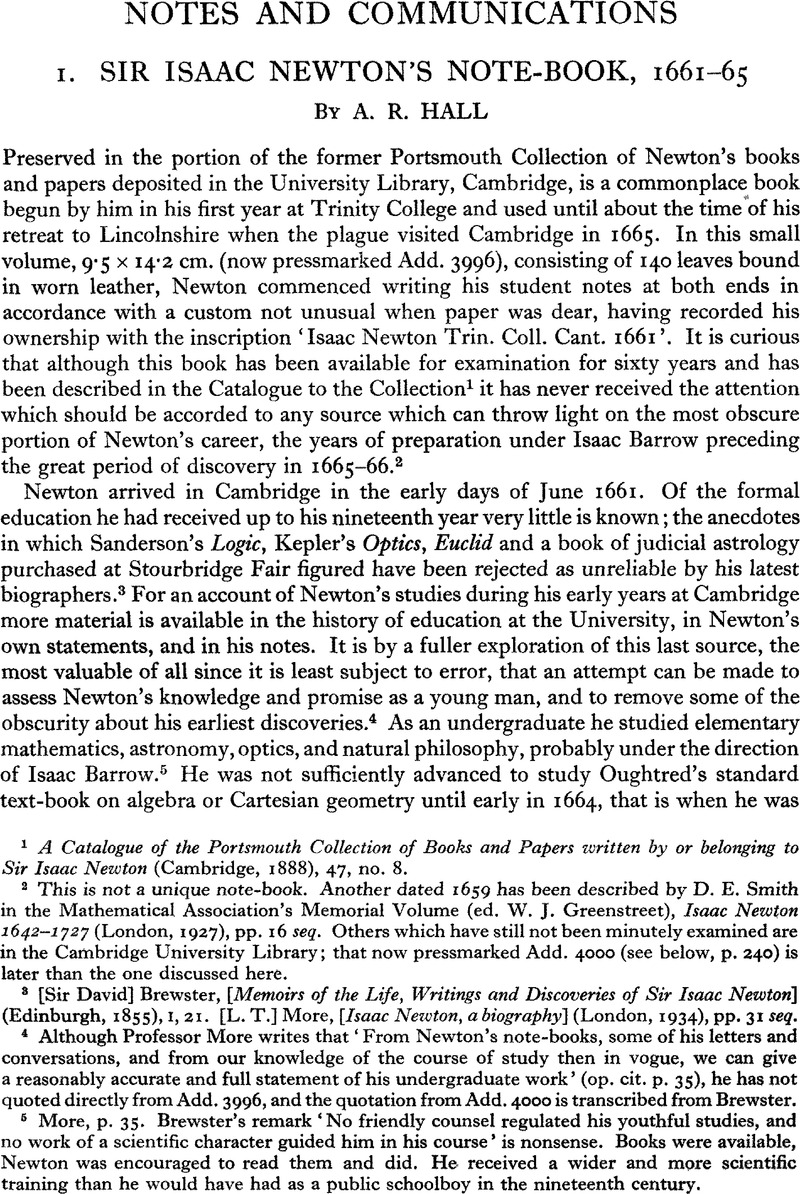Published online by Cambridge University Press: 20 December 2011

1 A Catalogue of the Portsmouth Collection of Books and Papers written by or belonging to Sir Isaac Newton (Cambridge, 1888), 47, no. 8Google Scholar.
2 This is not a unique note-book. Another dated 1659 has been described by D. E. Smith in the Mathematical Association's Memorial Volume (ed.,Greenstreet, W. J.), Isaac Newton 1642–1727 (London, 1927), pp.16seqGoogle Scholar. Others which have still not been minutely examined are in the Cambridge University Library; that now pressmarked Add. 4000 (see below, p. 240) is later than the one discussed here.
3 [David, Sir] Brewster, [Memoirs of the Life, Writings and Discoveries of Sir Isaac Newton] (Edinburgh, 1855), 1, 21Google Scholar. [, L. T.] More, [Isaac Newton, abiography] (London, 1934), pp. 31seqGoogle Scholar.
4 Although Professor More writes that‘From Newton's note-books, some of his letters and conversations, and from our knowledge of the course of study then in vogue, we can give a reasonably accurate and full statement of his undergraduate work' (op. cit. p. 35), he has not quoted directly from Add. 3996, and the quotation from Add. 4000 is transcribed from Brewster.
5 More, p. 35. Brewster's remark ‘No friendly counsel regulated his youthful studies, and no work of a scientific character guided him in his course’ is nonsense. Books were available, Newton was encouraged to read them and did. He received a wider and more scientific training than he would have had as a public schoolboy in the nineteenth century.
6 Brewster, I, 23; More, p. 36. As a textually accurate version of this famous passage has never, I think, appeared in print, it may be worth giving here. ‘July 4th 1699. By consulting an accompt of my expenses at Cambridge in the years 1663 & 1664 I find that in ye year 1664, a little before Christmas I being then senior Sophister, I bought Schooten's Miscellanies & Cartes's Geometry (having read this geometry & Oughtred's Clavis above half a year before) & borrowed Wallis's works & by consequence made these Annotations out of Schooten & Wallis in winter between the years 1664 & 1665. At which time I found the method of Infinite series. And in summer 1665 being forcedfrom Cambridge by the Plague I computed ye area of ye Hyperbola at Boothby in Lincolnshire to two & fifty figures by the same method. Is. Newton.’ (Add. 4000, f. 14.) Brewster's misreading of‘clean over’ for 7above’, copied by subsequent writers, considerably changes the sense of the passage. This note-book was begun December-January 1663 (O.S.).
7 Brewster, 1, 24–5; More, pp. 40–1.
8 Cooper, C. H., Annals of Cambridge (1843–1853), in,517–18Google Scholar.
9 There is little evidence of an interest in chemistry in his early notes. This may perhaps explain why Newton contributed less to the refoundation of this science, to which later he diverted so much of his attention, than to the physical sciences which were in the forefront of his mind during the critical period.
10 Add. 3968, no. 41, bundle 2. Newton was dissatisfied with the draft—perhaps because the dates do not seem to be entirely correct—and struck it out.
11 ‘Of ye Sunn Starrs & Plannets & Comets.’ Fol. 116.
12 This should dispose of the suggestion that Newton was almost ignorant of Greek, whilehis knowledge of written French at least is demonstrated by proof corrections in his own hand to Des, Maizeau's,Recueil de diverses pièces sur la philosophie, la religion naturelle, l'histoire, les mathématiques, &c. Par Mrs. Leibniz, Clarke, Newton & autres auteurs célèbres (Amsterdam, 1730)Google Scholar. These corrections are to be found in the Cambridge University Library copy, pressmark Adv. d. 39. 2.
13 Magiri, JohannisPhysiologiae Peripateticae Libri sex, cum commentariis. An edition was published in Cambridge in 1642Google Scholar.
14 At the top of the page in a fainter ink is written the tag ‘Amicus Plato amicus Aristotelis sed magis arnica veritas’. (Fol. 88.)
15 I surmise that Newton went through his book writing at the head of each page a likelyheading under which to collect his notes, classified by subjects; then filled up the spaces as his reading and thinking offered material. In several instances the spaces allotted to a subject were too small, so that hehad to continue in another place with a cross-reference; in others no entry was made under the page-heading (i.e. ‘Of Huidity, Stability, humidity, Siccity’, ‘Of figure, subtility, hebetude, smothnes, asperity‘, ‘Of Odours & Vapors’). (Fols. 95, 96, 106.)
16 The Immortality of the Soul, so farre forth as it is demonstrable from the knowledge of its nature and the light of reason (London, 1659)Google Scholar.
17 Fols. 88-9.
18 Even in 1713 Newton was careful to dissociate himself from Roger Cotes' attack on the Cartesian system in the Preface to the second edition of the Principia.
19 Fol. 93.
20 Fol. 93; continued on fols. 114–16.
21 Fols. III–12.
22 Fol. III.
23 Fol. 102.
24 Fol. 121. Galileo is quoted as saying that an iron ball falls 100 braccia(‘perhaps 66 yards’) n 5 seconds.
25 More, p. 40.
26 Ibid. p. 43. No reference is given to support this statement.
27 Brewster, 1, 27.
28 Quoted by More, p. 73.
29 Fol. 103.
30 Fol. 105. Cf. Antonius de Dominis, De Radiis Visis: ‘If some darkness be mingled with the light, which yet permits it a passage and is not completely absorbed, there then occur theintermediate colours.’ Quoted by More, p. 63.
31 Added in a later hand.
32 Blank in original.
33 Fob. 122-5, J33- Variants of the experiments noted are described in Newton's Optics (1704), Part 1, Proposition I.
34 Fol. 134.
35 More, p. 67. I have been able to discover nothing to relate the first optical experiments definitely to 1664.
36 Assuming either that the formula for a speculum metal is later than the notes on colour or that it has no direct connexion with the reflecting telescope.
37 Brewster, I, 19.